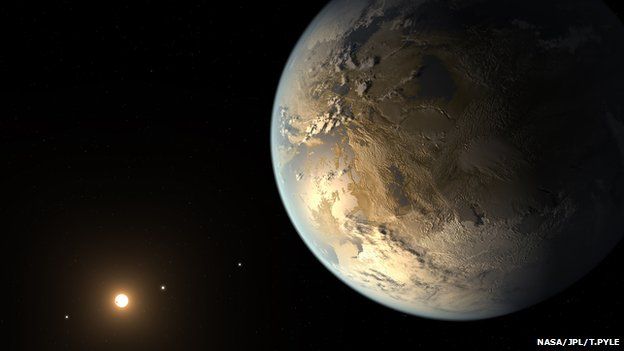'Most Earth-like planet yet' spotted by Kepler
- Published

The most Earth-like planet yet has been discovered, scientists report in the journal Science.
The rocky planet, Kepler 186f, is close to the size of Earth and has the potential to hold liquid water, which is critical for life, the team says.
Nestled in the Milky Way, it is part of a five-planet system that orbits around a cool dwarf star.
It was spotted by the Kepler telescope, which has found nearly 1,000 new worlds since its launch in 2009.
"This is the smallest planet we've found so far in the habitable zone," said Prof Stephen Kane, an astrophysicist from San Francisco State University, US.
Kepler 186f is about 500 light-years away from the Earth.
The researchers estimate that is a little bigger than our planet, with a radius that is about 10% larger than ours.
Because of its size, the team believes it is a rocky planet.
Prof Kane explained: "There seems to be a transition that occurs at about 1.5 times the Earth's radius, such that if the planet is larger, then it starts to develop a very substantial atmosphere very similar to what we see in the gas giant planets in our own Solar System.
"And so anything less than 1.5 is probably more like a rocky planet that we are familiar with."
Kepler 186f travels around a small and cool star. Of the five planets in the system, its orbit is furthest out and lasts about 130 days.
The team believes that it has the potential to hold water because with this orbital path it does not journey too close to its star for the liquid to boil away or so far out that it would freeze. Scientists call this region the "habitable zone".
Prof Kane said: "Even though it is orbiting a star which is very different from our Sun, the planet itself - both in terms of size and the amount of energy it is receiving from its star - is the most similar planet to our Earth that we've yet discovered.
"That is great news in terms of looking for planets which might actually be similar to the Earth, especially as the kind of star it does orbit - which is a very small star - are amongst the most common in the galaxy.
"And if all of these very common small stars have lots of terrestrial-sized planets in the habitable zone then that is very good news."
Scientists discover the most Earth-like planet ever found in another solar system, which may potentially hold liquid water
However, these small stars also tend to be more active than stars the size of the Sun.
So if Kepler 186f does have water - an essential ingredient for life - any potential organisms would be bombarded with solar flares and radiation.
The hunt for planets outside of our own Solar System has made remarkable advances in recent years.
The first was found just 20 years ago; now, nearly 2,000 have been spotted - many by the Kepler telescope.
However, a planet that is the same size as Earth, orbiting a star like the Sun, at the same distance has yet to be seen.
Such a find will almost certainly come with future technologies. The European Space Agency recently approved the development of an orbiting telescope called Plato, which will be tuned specifically to detect true Earth analogues.
Follow Rebecca on Twitter
- Published26 February 2014
- Published27 February 2014
- Published20 February 2014
- Published5 November 2013
- Published22 October 2013
- Published16 August 2013